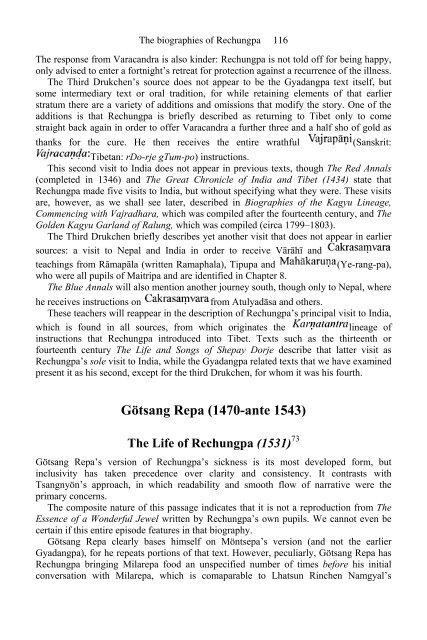The Biographies of Rechungpa: The Evolution of a Tibetan ...
The Biographies of Rechungpa: The Evolution of a Tibetan ...
The Biographies of Rechungpa: The Evolution of a Tibetan ...
You also want an ePaper? Increase the reach of your titles
YUMPU automatically turns print PDFs into web optimized ePapers that Google loves.
<strong>The</strong> biographies <strong>of</strong> <strong>Rechungpa</strong> 116<br />
<strong>The</strong> response from Varacandra is also kinder: <strong>Rechungpa</strong> is not told <strong>of</strong>f for being happy,<br />
only advised to enter a fortnight’s retreat for protection against a recurrence <strong>of</strong> the illness.<br />
<strong>The</strong> Third Drukchen’s source does not appear to be the Gyadangpa text itself, but<br />
some intermediary text or oral tradition, for while retaining elements <strong>of</strong> that earlier<br />
stratum there are a variety <strong>of</strong> additions and omissions that modify the story. One <strong>of</strong> the<br />
additions is that <strong>Rechungpa</strong> is briefly described as returning to Tibet only to come<br />
straight back again in order to <strong>of</strong>fer Varacandra a further three and a half sho <strong>of</strong> gold as<br />
thanks for the cure. He then receives the entire wrathful (Sanskrit:<br />
<strong>Tibetan</strong>: rDo-rje gTum-po) instructions.<br />
This second visit to India does not appear in previous texts, though <strong>The</strong> Red Annals<br />
(completed in 1346) and <strong>The</strong> Great Chronicle <strong>of</strong> India and Tibet (1434) state that<br />
<strong>Rechungpa</strong> made five visits to India, but without specifying what they were. <strong>The</strong>se visits<br />
are, however, as we shall see later, described in <strong>Biographies</strong> <strong>of</strong> the Kagyu Lineage,<br />
Commencing with Vajradhara, which was compiled after the fourteenth century, and <strong>The</strong><br />
Golden Kagyu Garland <strong>of</strong> Ralung, which was compiled (circa 1799–1803).<br />
<strong>The</strong> Third Drukchen briefly describes yet another visit that does not appear in earlier<br />
sources: a visit to Nepal and India in order to receive Vārāhī and<br />
teachings from Rāmapāla (written Ramaphala), Tipupa and (Ye-rang-pa),<br />
who were all pupils <strong>of</strong> Maitripa and are identified in Chapter 8.<br />
<strong>The</strong> Blue Annals will also mention another journey south, though only to Nepal, where<br />
he receives instructions on from Atulyadāsa and others.<br />
<strong>The</strong>se teachers will reappear in the description <strong>of</strong> <strong>Rechungpa</strong>’s principal visit to India,<br />
which is found in all sources, from which originates the lineage <strong>of</strong><br />
instructions that <strong>Rechungpa</strong> introduced into Tibet. Texts such as the thirteenth or<br />
fourteenth century <strong>The</strong> Life and Songs <strong>of</strong> Shepay Dorje describe that latter visit as<br />
<strong>Rechungpa</strong>’s sole visit to India, while the Gyadangpa related texts that we have examined<br />
present it as his second, except for the third Drukchen, for whom it was his fourth.<br />
Götsang Repa (1470-ante 1543)<br />
<strong>The</strong> Life <strong>of</strong> <strong>Rechungpa</strong> (1531) 73<br />
Götsang Repa’s version <strong>of</strong> <strong>Rechungpa</strong>’s sickness is its most developed form, but<br />
inclusivity has taken precedence over clarity and consistency. It contrasts with<br />
Tsangnyön’s approach, in which readability and smooth flow <strong>of</strong> narrative were the<br />
primary concerns.<br />
<strong>The</strong> composite nature <strong>of</strong> this passage indicates that it is not a reproduction from <strong>The</strong><br />
Essence <strong>of</strong> a Wonderful Jewel written by <strong>Rechungpa</strong>’s own pupils. We cannot even be<br />
certain if this entire episode features in that biography.<br />
Götsang Repa clearly bases himself on Möntsepa’s version (and not the earlier<br />
Gyadangpa), for he repeats portions <strong>of</strong> that text. However, peculiarly, Götsang Repa has<br />
<strong>Rechungpa</strong> bringing Milarepa food an unspecified number <strong>of</strong> times before his initial<br />
conversation with Milarepa, which is comaparable to Lhatsun Rinchen Namgyal’s











